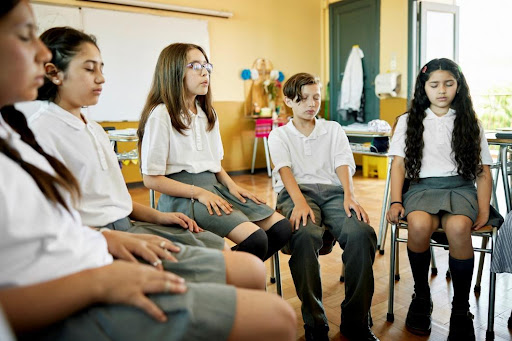Your work as a mental health counselor is crucial in determining and maintaining a child’s emotional welfare. Developing mental health awareness in today’s fast-paced and demanding world requires us to introduce mindfulness techniques to children. By utilizing mindfulness techniques within your lessons, you offer students the tools needed for improved self-awareness and resilience. This article provides practical advice on how educators can successfully use mindfulness practices when teaching kids about mental well-being.
Fostering mental health through mindfulness
To promote mental health through mindfulness, it is necessary to teach young people about the concept of mindfulness and how it can benefit them. Before proceeding, it is important to explain why practicing mindfulness and paying attention with an open mind is necessary. Present them with relatable scenarios from their daily experiences, like savoring different flavors in food and noting various physical sensations while playing. Using the five senses can be an efficient strategy for teaching kids about mindfulness, so urge your children to use all their senses while investigating the world around them through practices like sound listening and mindful breathing. Their awareness is broadened by the sensory experiences, which also assist in achieving a feeling of calmness and concentration.
Mindfulness necessitates one to be aware of themselves, and it is important for kids to learn how to observe their thoughts and emotions objectively. Becoming more self-aware enables them to grasp their internal sensations with ease and deal with difficulties using clear thinking along with compassion for themselves. To cultivate mindfulness effectively requires maintaining an attitude of gratitude. Encourage children to recognize and appreciate the good things that they are blessed with; to obtain the same outcome you could reflect on things that make you grateful or keep the record in a gratitude notebook. Training oneself to be thankful leads to feelings of satisfaction while maintaining a positive perspective in life.
Incorporating body awareness and movement into mindfulness practice is key to improvement, and encouraging children to perform simple yoga poses/stretches while paying attention to their physical reactions can be beneficial. The outcome of such practice is an improvement in the connection between their mental state (mind) and physical sensations (body), which leads to feelings of calmness and stability.
Being non-judgmental is a crucial part of practicing mindfulness. One important lesson for children is that all feelings and thoughts are real. Encouraging acceptance can help promote healthy emotional development. This approach nurtures kindness towards oneself, which leads to less criticism of one’s own actions while creating an environment that is conducive to examining your own thoughts.
Healthy relationships rely on effective and attentive communication for emotional well-being. Teach children how to be active listeners by paying attention to both verbal and non-verbal signals while demonstrating wisdom and empathy in response. Their social skills and comprehension of other people improve in tandem, so make sure to help kids include mindfulness in their everyday routines. By taking thoughtful breaks punctuated with deep breaths throughout the day, one can maintain centeredness, and by adopting mindfulness into their everyday life routine, children can develop a lifelong habit that promotes better mental health.
Creating a foundation for mindfulness practice
Establishing a base for the practice is vital when educating children on mental health and how to include mindfulness in their daily routine, as their ability to comprehend and implement mindfulness techniques relies heavily on this foundational knowledge. It is essential that you take several crucial measures to lay this foundation effectively.
Help kids grasp the concept of mindfulness by explaining it as paying attention to what is happening in the present moment without judging their thoughts or feelings along with being mindful of their surroundings and physical experiences.
Excite their curiosity and enthusiasm for practicing mindfulness by describing it to them as an engaging and useful talent that has the potential to enhance their daily life. Practicing mindfulness techniques can assist children in regulating emotions by nurturing the exploration of inner thoughts with curiosity.
Incorporating relatable situations is another effective method to create a strong foundation for mindfulness practice. Associate mindfulness with everyday tasks, like mindful eating or playfully engaging in physical activities. By presenting mindfulness in a relatable way that speaks to kids’ experiences, they can realize its potential for improving their lives.
Continuous learning
Teaching kids about mental health awareness while incorporating mindfulness techniques is greatly aided by cultivating a mindset of ongoing education and personal development. Keeping up with the newest innovations and best practices in mental health is essential for educators and caregivers so they can teach this knowledge effectively to children.
A recent graduate of the online Master of Arts in School Counseling program at St. Bonaventure University, Kristy Williams was interviewed about these techniques and the importance of a counselor to a child. Williams’ reasons for seeking a career in school counseling, her experiences in the area, and her insightful advice for teachers thinking about a career transition were all clarified in the interview.
Think of St. Bonaventure University as the spark that will enable you to turn your love of helping people into a fruitful and happy profession. You can start a journey that not only gets you ready for the licensed professional counselor exam but also gives you the skills and knowledge to succeed above and beyond with the Master of Science in Education programs in Clinical Mental Health Counseling and School Counseling.
Nurturing mindfulness abilities
Children’s mindfulness development is a transformational process that calls for persistence, direction, and regular practice. Here are some essential tactics for encouraging youngsters to develop their capacity for mindfulness.
Set the bar high by setting a good example. Children learn best by watching and copying their parents, so modeling mindfulness in your own life can have a significant impact on them. By remaining present, skillfully handling stress, and practicing self-care, you can demonstrate the benefits of mindfulness. Your genuine example of mindfulness will encourage kids to imitate you.
Establish a welcoming and nonjudgmental atmosphere. Encourage them to explore their feelings, thoughts, and sensations without judgment or condemnation. Encourage an environment of openness and acceptance where people feel free to express themselves. In mindfulness, it’s important to emphasize that there are no right or incorrect experiences and that every moment offers a chance for development.
Give children age-appropriate mindfulness exercises. Adjust the mindfulness exercises to the children’s developmental stage and areas of interest. Engage children in enjoyable, participatory activities that grab their interest and imagination. This could be guided visualization, mindful coloring, breathing techniques, or exercises that increase sensory awareness. Make the exercises interesting and accessible to encourage their participation.
Overcoming hurdles on the path to mindfulness
The path towards mindfulness can be hindered by various obstacles, particularly for children who may encounter several difficulties on the way. Children who possess unsettled thoughts could struggle with remaining attentive and present, which is an often-occurring problem. To conquer this, try commencing with short mindfulness activities and slowly elongating them as your focus lengthens. Using captivating strategies like guided imagery or sensory activities can enhance the appeal of practicing. Assistance in refocusing on the present can be provided through reminders and gentle prodding.
If quick benefits are not seen or if someone, particularly a youngster, has difficulty focusing, they can also become impatient and dissatisfied. Making sure they accept the process is vital. Developing mastery in mindfulness takes practice. Highlight the point that there is no correct method to practice mindfulness. No matter how brief, every moment of awareness holds importance.
People could encounter another difficulty with their resistance to unpleasant emotions, especially youngsters who encounter difficulty in accepting and owning up to agonizing emotions. They need to know that each emotion is genuine and ephemeral, deserving of observation and acceptance. Creating a secure and nurturing space where people can freely communicate and process their feelings is vital. Perhaps by seeing emotions as chances for learning and understanding, they can be encouraged to get over this obstacle.
Both internal and external distractions can make mindfulness practice challenging. Outside disturbances like noise or visual stimuli can break focus. When practical, endeavor to build tranquil and hushed surroundings. One can also aid children by teaching them methods of regaining focus on the present. Guiding them back to their breath using visual anchors or gentle reminders is helpful.
Creating a mindful support network
Anyone, including children, on the path to acquiring mindfulness must build a mindful support network. Through its support, direction, and sense of community, such a network can notably enhance their mindfulness practice. Creating a supportive network requires considering various essential elements.
Locate fellow practitioners who are dedicated to their own practice and possess a comparable fondness for mindfulness. Retreats, workshops, and joining mindfulness groups are of help. Contacting mindfulness teachers or practitioners nearby can also be of assistance. Creating alliances with people with a similar interest in mindfulness sets the basis for a robust community. Sharing knowledge and experience with each other benefits everyone involved.
Identifying individuals who are intrigued by mindfulness and promptly starting to hold frequent group mindfulness meetings is imperative. Members’ availability and interests will dictate whether these sessions would be in-person or online. Group meditation, discussions, or exercises centered around mindfulness are available for participation during these sessions. By gathering frequently, people can talk about their experiences, thoughts, and difficulties. They offer one another advice and direction.
Increase thoughtful communication within the support network and supplement with routine mindfulness workshops. Encouraging honest and considerate dialogue among the group’s participants is essential. The key elements of dialogues centered on mindfulness involve attentive listening, empathy, and refraining from judgment. Build a secure setting wherein people can share their experiences, request advice, and feel relaxed. Participants strengthen the support network through considerate dialogue that fosters a stronger connection and better comprehension.
A conscious support network facilitates sharing information and experiences. Sharing resources for mindfulness practice among participants is encouraged. This could include books, articles, apps, or guided meditation recordings. Sharing these materials can help everyone gain from different perspectives and mindfulness practices. Urge attendees to share their individual experiences, challenges, and insights about fostering mindfulness. Free sharing within the support network facilitates growth and mutual learning.
Foster gratitude and positive thinking
Instilling gratitude and optimism are vital components that aid in promoting the mental wellness of children. Teaching children about gratitude involves demonstrating it through actions and sharing the positive impact it can have on our lives. This study sought to discover how a gratitude intervention affected mental health and well-being among individuals in a community-based sample
Your contribution can assist young people in cultivating these characteristics. You can inspire a positive atmosphere that fosters appreciation and contentment by expressing thanks for small favors. Children can be modeled for it too.
Maintaining a gratitude diary is yet another positive practice. Boys and girls who are motivated to write or doodle what they feel grateful for daily become more familiar with noticing and valuing the good things they have. A positive outlook toward life can be developed with the help of this habit. This action will steer their attention toward positive aspects of life, irrespective of its scale. Thankfulness becomes routine.
Creating appreciation rituals, like a thankfulness jar or gratitude tree, amplifies how crucial it is to appreciate things. Kids can write or jot down things they appreciate to create visual cues that serve as continuous reminders to acknowledge and rejoice in moments of gratitude. Cultivating a positive mindset through this practice can help individuals appreciate the good things in their lives. These traditions encourage a thankful demeanor and proactive mindset.
Positive affirmations greatly foster optimistic thinking in children. You empower children to shift their perspectives by incorporating affirmations like ‘I am capable’, ‘I am loved’, and ‘I am grateful’. Having increased confidence can potentially lead to a more positive mindset. By stressing the power of affirmations and promoting positive self-talk, individuals’ mindsets and well-being can be significantly impacted.
Conclusion
Therapy sessions that include mindfulness practices can give children the necessary tools for conquering life’s obstacles. Mindfulness practice enhances emotional health, resilience, and a positive outlook as well. You can assist youngsters in living more meaningful and aware lives as a mental health specialist. Accepting the power of mindfulness will motivate young people in their pursuit of mental health awareness.





